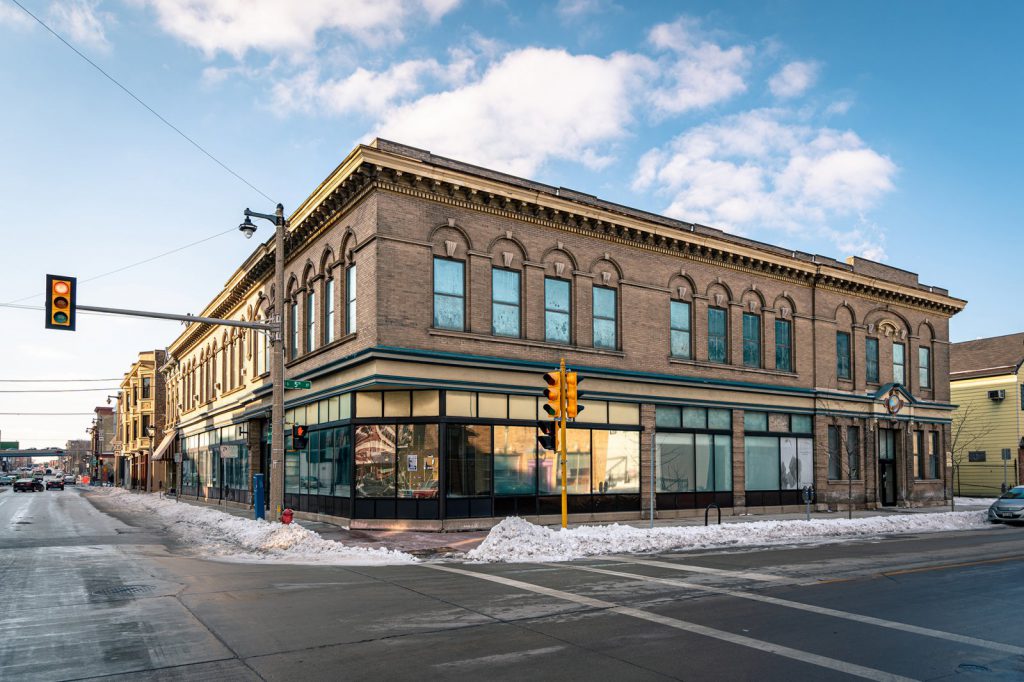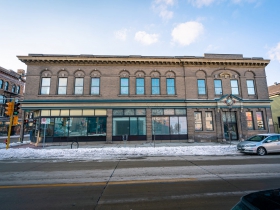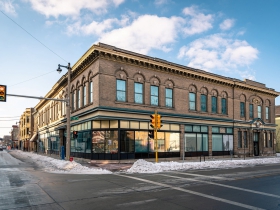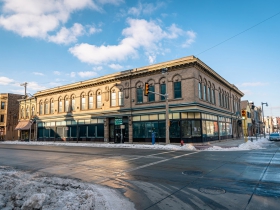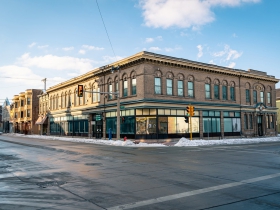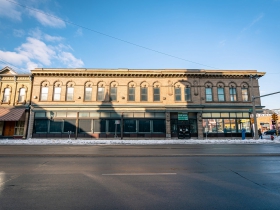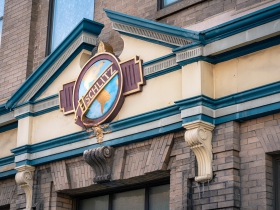Schlitz Tivoli Palm Garden Is a Classic
1901 Charles Kirchhoff, Jr. building at heart of city's largest concentration of historic structures
On January 22nd, it was announced that the “Social architecture agency NEWaukee is under contract to purchase and plans to redevelop the Historic Schlitz Tivoli Palm Garden building at 504 W. National Ave. in Walker’s Point.” The Beacon, as it will be called, will serve as offices for NEWaukee and its affiliates, and will include meeting and event space along with an independently operated cafe. “What’s more, it will be a melting pot for people and ideas. And, it will promote Milwaukee’s small businesses and social enterprises,” according to the release. The group has raised over $600,000 of its $3.4 million goal, and is seeking investors and tenants.
The 1901 Charles Kirchhoff, Jr. Walker’s Point building is on the northwest corner of S. 5th St. This is the most architecturally significant intersection of the city’s first historic district, which was designated in 1978, and contains Milwaukee’s largest concentration of intact early structures.
The building has been the tax-exempt home of the Milwaukee Ballet from 1981 until last year, when the company and its school relocated to a new building in the Historic Third Ward. For the first time in decades, this property is about to return to the tax rolls. Had it not been for the historic designation and the ballet’s tenancy following a disastrous fire that had reduced it to a shell, this lovely structure might have been demolished for a blighting surface parking lot.
The Building in History
Charles Kirchhoff, Jr. [1856-1916] was a favorite architect of the Uihlein family, and designed its opulent downtown Schlitz Palm Garden in 1896 as well as many less extravagant taverns in the pre-Prohibition Tied House era. This massive two-story structure with a footprint of more than 11,000 square feet was on a corner lot. There were six storefronts facing National Ave., while the entrance to the Tivoli Palm Garden was around the corner at 317-Grove St. (now 729 S. 5th St.) The palm garden occupied a 34-foot-by-49-foot main hall with a ceiling 30 feet above, topped by a dome, and most elaborately finished. There was also a tap room with a bar, attached to a kitchen in the rear. It was also served by restrooms for men and women, which was not so common among small neighborhood taverns back then. Still, the space was less than one-quarter of the first floor, most of which was given over to a parade of retail tenants and offices. Their occupants changed over the years, even as the near South Side neighborhood successively served as an entry point for immigrants from Germany, then Poland, then Mexico, and, lately, from the suburbs, as the preserved Walkers Point neighborhood regains its allure and draws metro area visitors to its bars and restaurants.
A Versatile Building
In 1894, this lot had a number of small frame buildings on it. The neighborhood had a polyglot of uses in the pre-zoning era, many of which would give the fire inspector the jitters today. There was a flour and feed elevator on the block, along with a carpet weaver, storage for old rags, storage for rags and iron, a cigar factory, a photo gallery, a sporting goods store and gun repair shop, a harness maker, a billiard parlor, a lodge hall, a bakery, a tailor and the Fifth Ward School, then under construction to serve the exploding population.
By 1910, an old mansion on the northeast corner of the block had already been converted to a rooming house, as it remains to this day.
In 1933, with Prohibition over, the tavern was legally operated by Louis Turck. Neighbors included the Spier Cigar Co., a vacant space, and a billiard hall. In 1940, Max Davidson sold men’s furnishings, and the South Side Dairy Lunch served up Blue Plate Specials from the storefront at 512 W. National Ave. In 1945, the Gin Wing Chinese Laundry opened next door.
The 1950s found the area in decline. Much of the building was occupied by the State Machine Tool Co., serving the city’s industrial base. Claremont Milwaukee Corp. sold television tubes from here, and was to remain until 1970; engineers and lawyers worked in offices upstairs. The old Palm Garden was closed. Its space was occupied by Popcorn Products Corporation. By 1972 the somewhat forlorn structure housed offices for the Wisconsin State Employment Services, Division of Department of Industry, Labor and Human Relations, employing 10 men and 16 women, whose job was to train others for jobs. In January 1979 a fire reduced the building to a shell. This was a great setback for the neighborhood, not to mention to the historically designated building.
Dancing to a New Tune
The Milwaukee Ballet, founded in 1970, decided to move to this building in 1981. With a great deal of effort, and no small amount of good luck, the company rebuilt the interior of the structure, even getting a waiver for its special flooring, which needed to be resilient for the sake of the dancers. The ballet and its school gave a new life to the building, and was quite an ornament to the old neighborhood. The ballet bought the building in 1997 for $610,000 and remained there until 2019, when it moved to its new home in the Third Ward. As a non-profit that owned the building for its exclusive use, the ballet was exempt from property tax. That is about to change.
Exempt, and Valued at $750,000
For years, the property carried a value of zero on the city tax rolls. But two years ago, as it became known that the ballet was to move, the assessor calculated that the structure would be worth about $750,000 when no longer tax exempt.
According to Steve Miner, the City Assessor:
Since the property was not being used for exempt purposes on January 1 it will be taxable for 2020 unless the new owner purchased the property prior to 1/1/2020 and they file, and are approved for a new exemption.
When determining exemptions, Wisconsin statutes are controlling. The use and ownership need to line up with the guidelines as spelled out in the statutes. The deadline for filing for new exemptions is March 1st. To answer your questions, the date of the sale may be a factor – the assessment date is January 1 – so the ownership on January 1 may impact the assessable or exemption status for 2020. Our office updates ownership records after reviewing deeds and transfer documents. Our staff is still processing December documents. We do not have the sale documents yet for this ownership transfer.
The Future of the Beacon
As of this writing, the building is under contract for an undisclosed sales price. NEWaukee’s plans to repurpose this old building for a new generation as an “entrepreneurship and innovation hub” is a testament to the resilience of our historic architecture in general and especially that of Walker’s Point, which is growing in vitality by the day. We have turned the corner thanks to the work of early preservationists, and the stewardship of the Milwaukee Ballet.
504 W. National Ave.
The Rundown
- Name of Property: Schlitz Tivoli Palm Garden (Historic); Milwaukee Ballet Jodi Peck Center (Recent)
- Address: 504 W. National Ave., 500-512 W. National Ave.; also 729 S. 5th St. Originally 392-402-National Ave., 317-Grove St.
- Assessed Valuation: The 14,614-square-foot lot is assessed at $18,200 ($1.25/s.f.) and the 15,899 square foot improvements are valued at $731,800 for a total assessed valuation of $750,000. Under Contract from CBRE at undisclosed price. [Brochure]
- Taxes: Levy Year 2019: Exempt. Had it not been, tax would have been approximately $19,552.50. Is expected to return to tax rolls for 2020.
- Owner: The Milwaukee Ballet; its headquarters from 1981-2019. Now vacant and for sale. Organization bought building 12/19/1997 for $610,000
- Type: Commercial
- Architect: Charles Kirchhoff [1856-1916]
- Year Built: The 2-story pressed brick and Bedford stone building was constructed in 1901. Kirchhoff also designed the downtown Schiltz Palm Garden and numerous other structures for the brewery and the Uihlein family
- Neighborhood: Walkers Point
- Subdivision: Week’s Plot
- Aldermanic District: 12th, Jose G. Perez
- Walk Score: 90 out of 100 “Walker’s Paradise” Daily errands do not require a car. It is just a walk one block south to W. Walker St. You are in your element here. City average: 62 out of 100
- Transit Score: 57 out of 100 “Good Transit” Many nearby public transportation options. City average: 48 out of 100
- Bike Score: 70 out of 100 “Very Bikeable” Biking is convenient for most trips. Plus, it is flat terrain. City average: 59 out of 100
- Wisconsin Architecture and History Inventory Record No. 42017
- Sanborn Maps 1894 Vol.3 Sheet #247
- Sanborn Map 1910 Vol.4 Sheet #404
- Listed in the National Register National Register; Listing Date: 12/19/1978
- Listed in the State Register State Register; Listing Date: 01/01/1989
If you think stories like this are important, become a member of Urban Milwaukee and help support real, independent journalism. Plus you get some cool added benefits.
What's It Worth?
-
Milwaukee Yacht Club Worth $2.28 Million
 Mar 27th, 2024 by Michael Horne
Mar 27th, 2024 by Michael Horne
-
Wisconsin Club Worth $5.1 Million
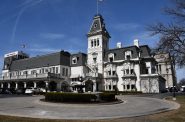 Mar 17th, 2024 by Michael Horne
Mar 17th, 2024 by Michael Horne
-
Woman’s Club of Wisconsin Is Nation’s Oldest
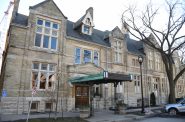 Jan 29th, 2024 by Michael Horne
Jan 29th, 2024 by Michael Horne


